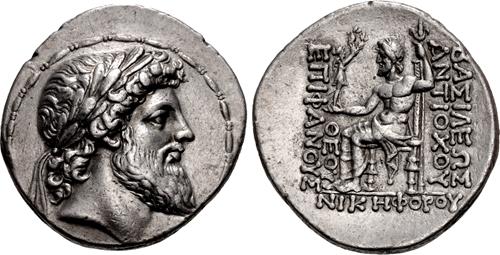
|
SELEUKID EMPIRE. Antiochos IV Epiphanes. 175-164 BC. AR Tetradrachm (31mm, 16.61 g, 12h). Antioch on the Orontes mint. Series 3, struck 168-164 BC.
Triton XXIII – Session Two – Greek Coinage Part II through Roman Imperial Coinage Part I
Lot: 468. Estimated: $ 4 000
Greek, Silver
Sold For $ 5 500. This amount does not include the buyer’s fee.
Go to Live
|
|
SELEUKID EMPIRE. Antiochos IV Epiphanes. 175-164 BC. AR Tetradrachm (31mm, 16.61 g, 12h). Antioch on the Orontes mint. Series 3, struck 168-164 BC. Bearded head of Zeus right, wearing laurel wreath / BAΣIΛEΩΣ ANTIOXOY ΘEOY EΠIΦANOYΣ NIKEΦOPOY, Zeus Nikephoros seated left; no control marks. SC 1398; Le Rider, Antioche, Series IIIA, 226–7 (A22/P160) = Mørkholm Series III, 14, dies A23/P95; HGC 9, 620a; CSE 106 = Pozzi 2963; SNG Spaer 1003; Boston MFA 2165 (same dies); Dewing 2584 (same obv. die); Gulbenkian 1039 (same obv. die). Lightly toned. Near EF. Struck from dies of fine style. Rare.
From the Weise Collection. Ex Triton IX (10 January 2006), lot 1025.
Newell (SMA, p. 30) identifies the tetradrachms with the head of Zeus on the obverse as a special issue for the festival of Daphne. His theory depends heavily on the story that Antiochos IV erected a copy of the celebrated Phidian cult statue at Olympia within the temple of Apollo at Daphne. But this story is now in disrepute (see Lacroix, BCH LVVIII, pp. 165-6). More recent scholarship suggests that this special issue, which introduces to his coinage the epithet Νικηφορου, was struck to commemorate Antiochos' victorious return to Antioch following the conclusion of his second Egyptian campaign.
The heads of Zeus on these tetradrachms are of two types, one of them sharp featured and slightly archaizing, the other, as here, softer and apparently with the features of Antiochos himself. A number of scholars have taken this as evidence that Antiochos identified himself with Zeus. However, Mørkholm (pp. 58-61), followed by Houghton (JPGMJ 10, p. 157), argues that the resemblance is the result of the tastes or habits of the engravers. Mørkholm furthermore contends that the resemblance of the Apollo heads as well disqualifies the notion of a divine identification. But this is to overlook the essentially syncretic nature of divine kingship, as is symbolized iconographically by coin portraits of Ptolemy III with attributes of three gods. In this context it should also be recalled that Antiochos IV introduced the radiate diadem to Seleukid coinage, a symbol of royal apotheosis that alludes to Helios, and added ΕΠΙΦΑΝΗΣ, "God Manifest," to his royal titles.
The final winners of all Triton XXIII lots will be determined at the live public sale that will be held on 14-15 January 2020. Triton XXIII – Session Two – Greek Coinage Part II through Roman Imperial Coinage Part I will be held Tuesday afternoon, 14 January 2020 beginning at 2:00 PM ET.
Winning bids are subject to a 20% buyer's fee for bids placed on this website and in person at the public auction, 22.50% for all others.
|
